How Much Further Can Oil Prices Fall?
04:27 July 8, 2025 EDT
Key Points:
https://www.chinanews.com.cn/cj/z/sanlihe/index.shtml
1. OPEC+ announced an August production increase that exceeded market expectations, triggering a drop in oil prices.
2. If OPEC+ continues to ramp up output while tariff risks materialize, oil prices could face further downside.
3. Analysts widely believe that the risk of oversupply may emerge later this year, keeping oil under pressure in the near term.
In early July 2025, the international crude oil market experienced renewed volatility. Despite ongoing geopolitical tensions in the Middle East
and the Northern Hemisphere entering its traditional demand season, oil prices failed to rebound. Instead, they plunged following OPEC+’s
unexpected decision to boost production.
At the same time, rising uncertainty around U.S. trade policy has added to market concerns. Although former President Trump’s delay in
implementing tariffs temporarily eased pressure, it also heightened fears over future global economic growth and energy demand.
As of publication on July 7, WTI crude stood at $65 per barrel, while Brent crude traded at $68 per barrel, both sharply lower from the
previous trading session.
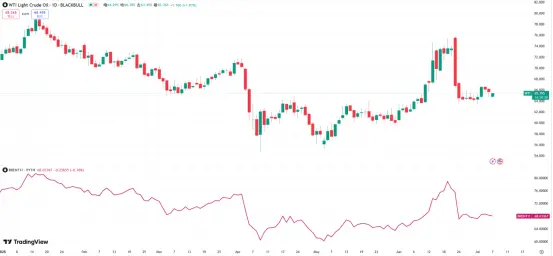
Source: TradingView
OPEC+ Output Boost
On July 5, eight key OPEC+ member countries reached a consensus during a virtual meeting to increase oil production by 548,000 barrels
per day (bpd) in August—well above the market’s prior expectations of a 411,000 bpd increase.
This decision marks a strategic shift for the oil-producing bloc. Amid weakening global economic growth and softening demand, OPEC+ had
implemented a voluntary output cut of roughly 2.2 million bpd starting in October 2022. However, beginning in April this year, the alliance—
led by Saudi Arabia—pivoted toward aggressively ramping up production. The group scrapped the 2.2 million bpd cut in April and followed
with production increases of 411,000 bpd in May, June, and July, respectively. The 548,000 bpd hike for August further accelerates this
reversal.
With this move, OPEC+ is now on track to fully unwind the 2.2 million bpd supply cap—originally set to last through 2025—a full year ahead
of schedule. Since April, the bloc has restored a cumulative 1.918 million bpd of output, leaving just 282,000 bpd yet to be recovered.
According to a statement from the OPEC Secretariat, the production hike was made in response to a stable global economic outlook and
healthy market fundamentals. However, the increase comes at a time when global oil inventories are rising by around 1 million barrels per
day, potentially exacerbating an imminent supply glut and putting further downward pressure on international oil prices.
Tariff Impact and Global Demand
The Trump administration’s trade policy has also emerged as a key external factor influencing oil prices. A new round of reciprocal tariffs,
originally scheduled to take effect on July 9, has been delayed until August 1. While the postponement temporarily eased market concerns
over a hit to global demand, it did not eliminate the underlying risk.
According to public statements from Treasury Secretary Bessent and White House economic adviser Hassett, the U.S. plans to impose
punitive tariffs ranging from 10% to 70% on various countries depending on whether trade deals are reached. Although agreements have
been secured with some nations—such as the U.K. and Vietnam—overall negotiations are progressing slowly.
If the tariffs go into effect as planned in August, they could place pressure on oil-intensive sectors such as manufacturing and transportation,
indirectly weighing on crude demand. The international energy market is actively repricing the macroeconomic impact of growing trade
uncertainty, and oil prices are beginning to reflect these downside risks.

The International Energy Agency (IEA) projects global oil supply will rise by 1.8 million barrels per day in 2025 to 104.9 million bpd, outpacing
demand growth of just 740,000 bpd. This demand growth is slower than the 1.3 million bpd increase seen in 2024 and is primarily driven by
non-OECD countries. Key markets such as China and India are showing signs of weak demand, while OECD nations are expected to see a
demand decline of 120,000 bpd. This outlook supports expectations for rising inventories and further downward pressure on oil prices.
Support Factors Weaken
Since mid-June, tensions in the Middle East have flared up, briefly boosting oil prices as markets reacted to conflict between Israel and Iran.
On June 13, crude prices surged nearly $5 per barrel in a single day. However, U.S.-led diplomatic and military intervention helped de-
escalate the situation. On June 24, President Trump announced that Israel and Iran had reached a ceasefire agreement in principle, quickly
easing market risk sentiment.
Although sporadic clashes have continued following the ceasefire, markets broadly expect the latest geopolitical flare-up to remain
contained. From a technical standpoint, oil has given back all its gains driven by the earlier conflict. WTI crude has fallen from a recent high
of $77 per barrel to around $65, while Brent has dropped to $68, with both benchmarks breaking below key support levels.
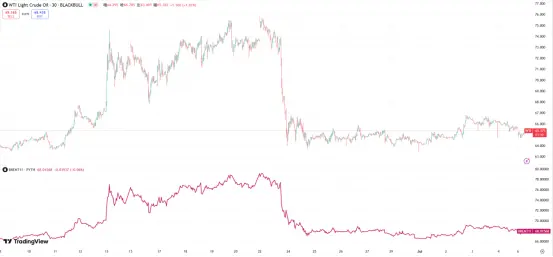
Source: TradingView
Geopolitical risks are increasingly being overshadowed by supply-side dynamics. The Middle East, once a key catalyst for oil price rallies, no
longer offers decisive support under current market conditions.
Technical Weakness
Crude oil prices are showing a bearish trend.
On July 7, Brent crude was priced at $67 per barrel, approaching the lower bound of the recent $60–70 range. Key support levels stand at
$65 and $58 (the April 2025 low), while resistance is seen at $70 and $77, where the mid-June geopolitical-driven rally was previously
capped. The Moving Average Convergence Divergence (MACD) indicator remains negative, supporting the bearish outlook. Volume analysis
indicates increased selling pressure following the OPEC+ production hike announcement, reinforcing the downward momentum.
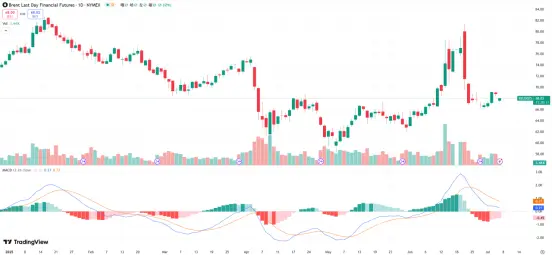
Source: TradingView
WTI crude is trading at $65 per barrel, with support at $62 and $57 (May 2025 low), and resistance at $68 and $72. WTI’s technical profile
mirrors that of Brent, showing a negative MACD and declining volume. The summer driving season could provide some short-term demand
support.
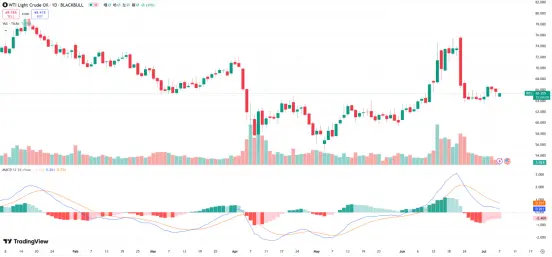
Source: TradingView
Historically, whenever OPEC+ has released large volumes of production or market expectations reversed, oil prices have faced deep
corrections. For example, in the second half of 2018, OPEC’s relaxation of production cuts coupled with rising U.S. shale output led to a more
than 35% drop from the October peak; similarly, the Saudi-Russia price war in March 2020 instantly pushed prices to historic lows.
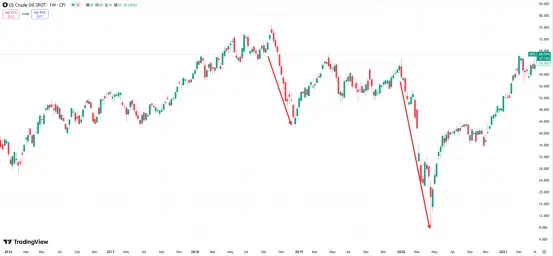
Source: TradingView
The current situation bears resemblance to these episodes—major producers are willing to sacrifice price to defend market share, while
demand is constrained by macro uncertainty and rising inventories. Although some risks are priced in, if OPEC+ continues to increase
production alongside tariff risks materializing, further downside pressure on oil prices remains.
Analysts at ING and Barclays have lowered their 2025 Brent price forecasts to $65 and $66 per barrel respectively, reflecting expectations
of supply surplus. Goldman Sachs forecasts a 1 million barrel-per-day oversupply in 2025, increasing to 1.5 million barrels per day in 2026,
further weighing on prices.
Disclaimer: The content of this article does not constitute a recommendation or investment advice for any financial products.

Email Subscription
Subscribe to our email service to receive the latest updates
